The MSI GT75 Titan Laptop Review: Hex-Core DTR
by Brett Howse on September 13, 2018 9:00 AM EST- Posted in
- Laptops
- Gaming
- MSI
- Pascal
- Coffee Lake
- Coffee Lake-H
Design
MSI have a pretty recognizable aesthetic, and the GT75 Titan follows in that mold. As is normal with MSI, all the outside edges that you’d normally touch are capped with aluminum, but the bottom of the laptop you’ll never see is built out of plastic. There’s only one color option – Aluminum Black – and some tastefully placed LED lighting on the back of the display, and a red light on the keyboard deck which doubles as a power button.
We’ve moved to an era where you come to expect thin display bezels, but gaming laptops haven’t quite gotten there yet. On a 17.3-inch device like this, there’s easily room for the 18.4-inch display from the MSI GT83VR Titan which we reviewed last year, but MSI would be stuck in the same boat as they are with that device where they can only get a 1920x1080 60 Hz display. Shrinking the laptop dimensions to put smaller bezels on the 17.3-inch that’s in there now would remove room for cooling. So, for now at least, the GT75 Titan looks a bit like last year’s laptop.
The build quality of MSI gaming laptops tends to be pretty good, and the GT75 Titan doesn’t have any of the creaks or groans of some other gaming laptops on the market. Even though the device is over 10 lbs, there’s no flex at all in the chassis when picking it up on one end. MSI laptops always feel well built, and the GT75 Titan is not an exception.
Opening the laptop up, you can see one of the stars of the show. MSI has outfitted the GT75 with a SteelSeries mechanical keyboard, and it offers per-key RGB lighting. This keyboard is a treat to use, especially compared to some of the less expensive devices on the market. There’s a reason why mechanical keyboards are so popular. The feedback is wonderful, and although this doesn’t match a traditional desktop mechanical keyboard for key travel, there’s still plenty of travel available. MSI does offer the GT83VR Titan with a mechanical keyboard mounted at the front, and that device is much closer to a desktop, but in the normal laptop layout, the GT75 is probably one of the best around.
The per-key lighting isn’t just a gimmick either. MSI offers default modes to set the lighting for different gaming styles, so different key combinations are illuminated, or you can just choose your own preference and set it exactly how you would like it to be. MSI also has a nice trick when the function key is pressed. All other keys turn off except those that have a function available, so you can more quickly find the one you want. It sounds small, but it really is a nice feature.
If there were any quibbles about the keyboard, they would be relatively minor. The Fn key is in an odd location right of the space bar, compared to most laptops, although it can be swapped with the Windows Key in software. Also, the key pad, like most laptops, is a bit squished, but thankfully the arrow keys are well placed and full sized.
There’s also five buttons on the right side of the keyboard deck. The top one is the power button, Below that is a button to launch the MSI Dragon Center, which is their control panel to access all of the settings for the laptop. Next is the fan speed control, which toggles it between automatic and maximum fan. Second from the bottom is a button to launch XSplit Gamecaster, and the last button launches the SteelSeries software.
The track pad is generously sized, and offers a nice smooth surface for scrolling. It features physical buttons as well at the bottom, and there’s customizable lighting you can set for both the left and right buttons. The Synaptics touch pad works pretty well overall, but it does seem to have a tendency to sometimes register taps as a downward movement which can be annoying. If you use the mouse keys, that’s not an issue, but it was a bit frustrating to use the touch pad. On a gaming laptop, that’s a small annoyance though, since it’s most likely to be used with a mouse anyway.
The attention to detail on the keyboard deck also carries into the markings on the laptop, which are all etched into the aluminum, so they can’t rub off. It’s another small detail that works well.
On the sides and back is an almost ridiculous number of ports, with five USB 3.1 Gen 2 Type-A ports on the sides, along with the four 3.5 mm jacks for audio, an SD card reader, and a locking slot. On the rear is the Thunderbolt 3 USB-C port, along with both mini DisplayPort and HDMI 2.0, a five pin power connector, and the 10 Gigabit Ethernet jack.
The underside of the laptop is almost entirely covered in air vents for pulling in cool air, and there’s large exhaust ports on both the sides and the back. This is a big, thick, heavy laptop, but all of that cooling is important for what’s inside.


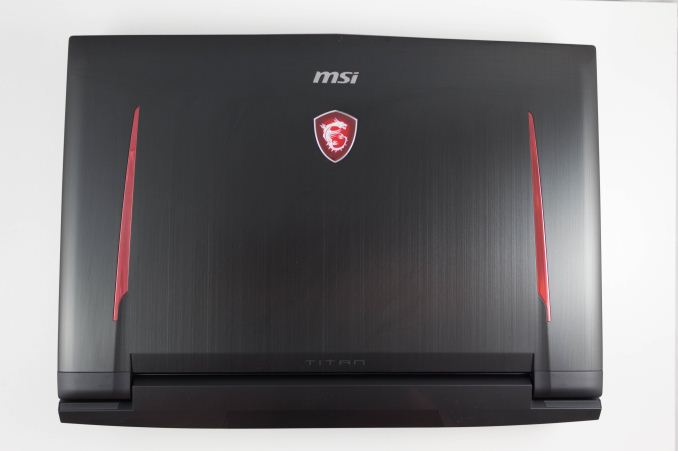
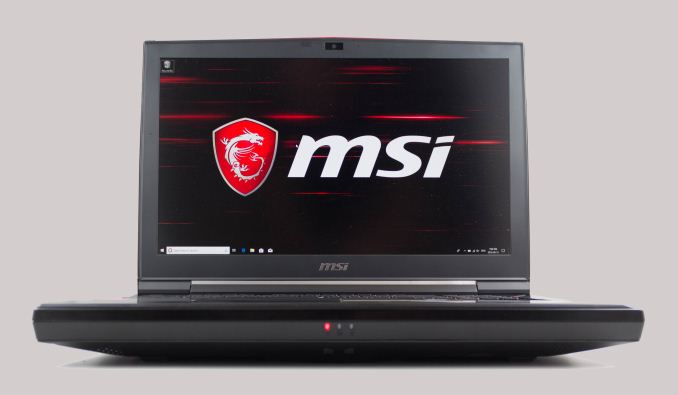
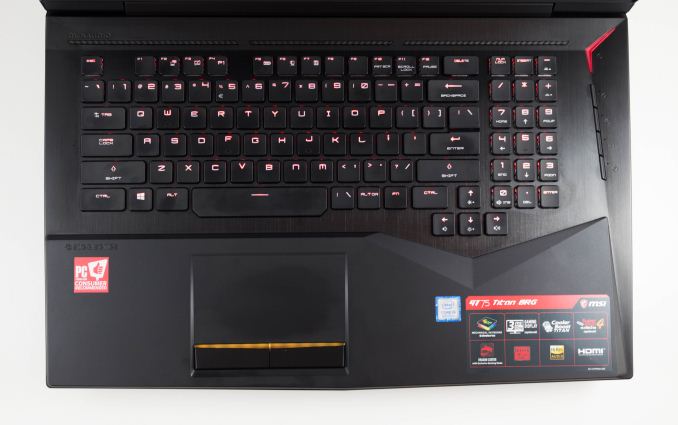
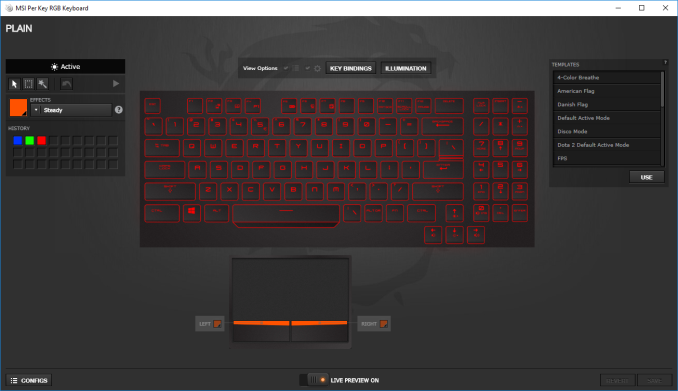
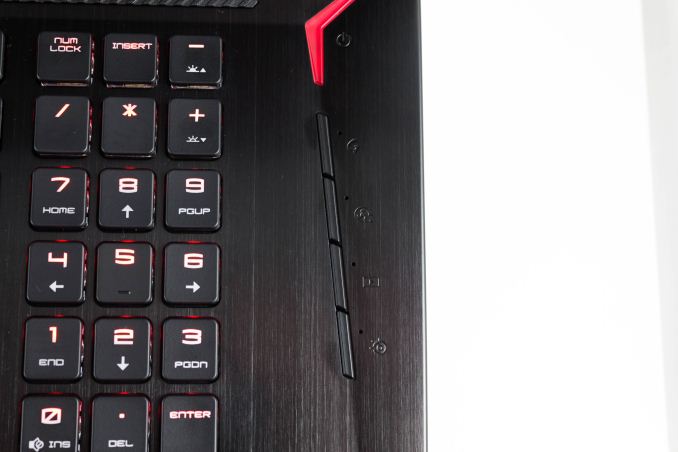











48 Comments
View All Comments
DanNeely - Thursday, September 13, 2018 - link
At least on high end laptops like this one, I'd be interested in seeing 1440p/4k results when possible. Yes, for most titles that's still going to be an aspirational target, for another year or two; but with current high end GPUs being overkill for 1080p seeing how much farther you can push is useful; and 2080SLI (when supported) and the upcoming 7nm generation will likely be able to hit acceptable framerates in at least some titles and being able to look back against the prior generation will be beneficial.darkich - Thursday, September 13, 2018 - link
I find it beyond ridiculous that you're actually fine with a 1080p TN with this screen size and this GPU, for this price in this day and age!Can someone please explain..why would anyone need hulking 1080p POS if there are many laptops that are less than half lighter, far sleeker, cost half the price and can play EVERY game at 1080p 60fps?!?
darkich - Thursday, September 13, 2018 - link
..heck, excuse me but I have to straight up say that anyone buying this with a 1080p screen is a total idiot, sorry.Just see no point.
darkich - Thursday, September 13, 2018 - link
..oh and also, why are you ignoring the fact that not being able to play at 4K 60fps is NOT an excuse for not having a 4K screen??Is it that complicated to lower the resolution in the game settings??
Brett Howse - Thursday, September 13, 2018 - link
If you can't see the point of a 120 Hz display versus a 60 Hz display then I don't think anyone will be able to help you.darkich - Friday, September 14, 2018 - link
Fair enough.I'd still take a far more quality and detailed image on a 17" over grainy 120Hz any day
Brett Howse - Friday, September 14, 2018 - link
Well if you really are interested in this laptop but the 1920x1080 is holding you back, they do have a 3840x2160 IPS with G-Sync as well.darkich - Sunday, September 16, 2018 - link
Soo..that brings us back to my initial point, right?Why are you wasting your time on this 20 year old screen specs then?
Why aren't you reviewing the said IPS option instead ?
Benchmarking this laptop would only make sense at at least 1440p and with a screen that can actually showcase games in their full glory.
GreenReaper - Sunday, September 16, 2018 - link
They're reviewing it because people in the world *other* than you might want to buy it. If your needs lie elsewhere, that's fine. It doesn't make the product or reviews of it worthless.If colour gamut or viewing angles were the sole purchasing criteria, we'd all be using IPS screens over TN/VA. At this point in my life, and the current state of the market, I might well buy one myself. But a 120Hz screen _can_ give you a more well-defined picture of a moving object than a higher-resolution 60Hz screen, and that *may* be more important to a buyer - especially if they're trying to hit a small point on that moving object. And as mentioned above, it can avoid what some see as downsides such as desktop scaling.
There are reasons cameras have shutter speeds faster than 1/60sec as well, and one of them is because it gives you a sharper image of moving objects. Which, again, many games are full of. High-resolution textures would be wasted if they end up as a blurred mess.
There's little point in benchmarking in 1440p on an 1080p laptop because that is not how it will actually be used - and you're unlikely to swap the monitor out later (although it would be possible to plug a larger one in, I guess - in fact, that would be a *great* way to get that 4K IPS action as well).
For the inbuilt screen, antialiasing is a better way to provide image quality and use up the available video performance - and that's exactly what was tested with full-screen anti-aliasing and temporal anti-aliasing.
If I were to criticise the reviews, it would be that they seem to be an average FPS, which doesn't really cut it nowadays - I want to see 99% values, or number of frames it doesn't meet the target, because that's when you notice performance dropouts. But in many games the laptop exceeds the 120 FPS target, while in others it's still above 90 FPS. So it should deliver this particular model's key feature - high-FPS gaming.
milkod2001 - Friday, September 14, 2018 - link
For 17'' screen lappy 1080p is perfectly fine.